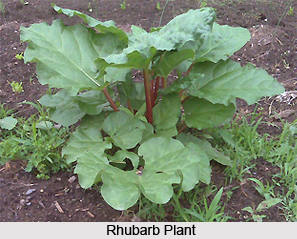 It is one of the oldest registered herbal drugs; mentioned in a Chinese herbal remedy, dated approximately 2700 B.C. Rhubarb was inaugurated in Europe in relatively later times. It arrived in Britain only in the 16th century. It is now cultivated to a restricted degree in India and Central Africa.
It is one of the oldest registered herbal drugs; mentioned in a Chinese herbal remedy, dated approximately 2700 B.C. Rhubarb was inaugurated in Europe in relatively later times. It arrived in Britain only in the 16th century. It is now cultivated to a restricted degree in India and Central Africa.
Methods of usage
Rhubarb comes to essential use of people in case of chronic diarrhoea, constipation, poison ivy or numerous other infectious diseases.
Healing Power and Medicinal Properties of rhubarb
The herb is acrid and sour to taste. It amplifies the secretion and disposal of urine.
Constipation healed by rhubarb
Rhubarb is utilised in allopathic medicine mostly as a laxative. It also contains tannins and thus, after purgation, it produces an astringent effect which induces constipation. It is thus suited only in modest cases of constipation and not in persistent ones.
Diarrhoea healed by rhubarb
Due to its astringent action, rhubarb can be consumed with favourable results in cases of diarrhoea caused by the existence of nettlesome substances in the intestines.
Children`s Ailments cured by rhubarb
Rhubarb is a valuable everyday therapy in complaints of children. It is a harmless laxative and also reduces too much acidity in the digestive tract of children. Sometimes children develop diarrhoea due to unnecessary consumption of milk, inducing putrefaction and consequently aggravating the degree of acidity in stomach. Rhubarb releases the putrefied faecal matter, simultaneously lessening the acidity. In spite of its constipative after-effect, the motion stops automatically after bowels are cleaned. The preferred dosage is one gram for infants` upto 2 years old.
Poison Ivy cured by rhubarb
Rhubarb is one of the successful household curatives for poison ivy. Raw rhubarb rubbed over the area where it prickles, brings alleviation. The treatment must be reiterated if scratching continues.
Other Disorders healed by rhubarb
Rhubarb is also useful in treating biliousness, lumbago, excited mind, painful eyes, piles, acute bronchitis, chronic fever, asthma and coryza, hurtings and bruises.
Precautions
- Rhubarb contains a substantial amount of oxalic acid. Everyday usage can lead to the formation of stones both in the kidney and bladder and perturbing nervous symptoms. It should be averted altogether by those who have an inclination for injuries, gout, rheumatism, epilepsy and other related diseases with uric acid.
Other Uses of rhubarb
The juicy petioles or leafy stalks are used for manufacturing pies and sauces.
Composition
Rhubarb is a big, perpetual herb which has extremely sturdy stems and roots with enormous basal leaves. The dried rhizomes, i.e., the underground stems yielding roots and leaf shoots of the plant, make up the drug. The rhizomes should be compiled from six or seven year old plants, just prior to the blossoming season. The root barks should be held back.
An analysis of rhubarb stalks illustrates it to consist satisfying amount of moisture, protein, fat, minerals, fibre and carbohydrates. Their mineral and vitamin contents include calcium, phosphorus, iron and vitamin C. Its vital energy value is 26.
The rhizomes of rhubarb produce glucoside rhaponticin and chrysophanic acid. The chief components of the herb are antheoquinone derivatives. The roots contain rhein and emodin. The rhizomes also produce a volatile oil containing eugenol, a terpene alcohol and a product thought to be methyl heptyl ketone.



















